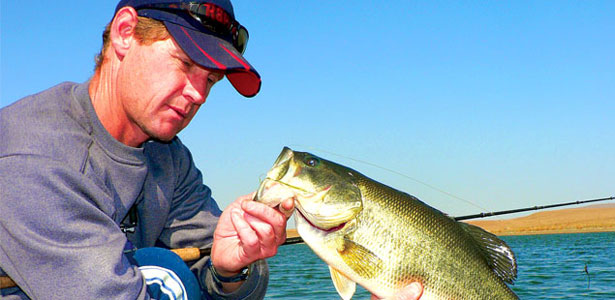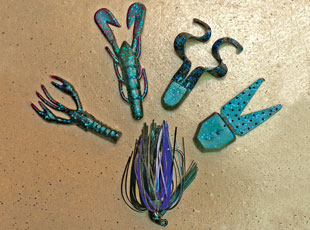Tackle Techniques
The Anatomy of Jigs
- Details
- Written by Andrew Court

One of the things that I have noticed over the years is the fact that not many anglers fish jigs. Understandably they can be difficult baits to fish and build confidence in but they are awesome fish catchers and have saved the day for me on many an occasion. Why this is I can probably put down to a number of reasons- firstly I think that bass don’t see these baits often, especially on pressured water, and in addition the jig is a bait that has all the elements needed for a bass to react positively to.
Of course this all depends on how effectively you fish the bait, and like many other baits requires the angler to move it enticingly to induce the strike. Jigs are not only effective as heavy cover wood and weed baits but can also be used in a myriad of other situations from rocks or rip rap to open, deep water drop offs, ledges, points and humps. They can be crawled or hopped along the bottom to finesse lethargic bass or swum and dropped fast to excite active feeders. To get the optimum performance and results out of your jig, here are a few pointers.
Although the term jig generally refers to a hook embedded into a leadhead onto which we can add a soft plastic grub or something similar, the classic bass jig is quite unique in its design. A good understanding of the various head shapes, hook sizes, weed guards and other appendages can go a long way in enabling it to be fished effectively in different situations.
Jigs can be basically divided into 6 groups, namely:
Bucktail jigs -these have either hair or bucktail as a skirt and area lso popular saltwater lures but are arguably the least used of the jig family in freshwater. They can be used with a plastic or pork trailer and can be very effective in current or cold-water situations.
Flipping jigs –these jigs are designed to facilitate fishing in thick cover such as brush and weed. They are heavier than standard weedless jigs, from ½ - 1 ounce, and are generally used for short line pitching and flipping presentations. They usually have shorter, stronger hooks, stiffer more upright weed guards and head designs that allow for easier movement through cover.
Weedless jigs –these are standard jigs for bass in sparse to moderate cover and although often look like a flipping jig, have a light to medium gauge hook that is often slightly longer than a Flipping jig and are better suited for flipping or casting. They are lighter, ¼ - 3/8 ounces, generally have more flexible, angled weed guards, and their head designs can vary from standard round to football shapes for fishing around different types of cover or substrate.
Finesse jigs –These are smaller and lighter in the 1/8 – 5/16 ounce range and are best suited for clear or cold water, or any time when bass need to be finessed. They generally look the same as the larger jigs but often have light weed guards, hooks and no rattles.
Spider jigs –this is basically a soft plastic bait that is designed to resemble a jig and has a tentacled collar attached to a twin tail grub. The bait is rigged onto a plain jig head with an exposed hook or can be rigged Texas style with a pegged weight.
Casting or Swimming jigs – these jigs are primarily used for swimming techniques and are great alternatives to cranks or spinnerbaits. They have more streamlined head designs, light to medium hooks, thinner weed guards and are best suited for casting techniques in and around sparse to medium cover or deeper structure with a drop-and-go technique.
The common element unique to most bass jigs is the built-in weed guard, interchangeable rubber skirt and on many models the rattle chambers. However the head design of the jig is one of the most important aspects to consider when choosing a jig for a technique, and more so the angle of the line tie. The head shape and line tie will determine the jig’s ability to move through cover, and generally is either positioned at a right angle at the top of the head, at about 30- 60 degrees, or straight off the nose. If you want to fish grass or weed for example, a jig with the line tie that protrudes straight off the nose will come through that cover a lot easier than one that has a 90-degree line tie. The same can be said for dragging or bouncing a jig along the bottom where a 30- 60 degree line tie will give you a better pull angle on the jig, keep it more upright and allow for a better hook set. The way in which the line tie protrudes from the jig head is another consideration and a horizontal eye will catch on wood or rock more than a vertical eye. This is not entirely a bad thing as it allows you to bump and shake the bait to draw a strike, but if you are fishing in weeds or grass you want a vertical eye that hangs less and slides through easier. The same can be said for the actual head shape of the jig that needs to match the type of cover you are fishing. Weeds, grass or swimming techniques call for a more streamlined or aerodynamic head design, but when fishing wood, rocks or brush it is often better to use a jig that has some width or shoulders to it which allows the jig to bounce and jump off the cover.
In Practice
This brings us to fishing the jig, and it is vital to be a touch-and-feel type angler to fish this bait effectively. By that I mean you really need to focus on and get really accustomed to how your jig feels as you fish it through the cover. This is a bait where you get to learn what is not a bite – anything else is a bass! By “reading” the bottom with your jig you can get it to jump, shake, quiver or even lie still to allow the skirt to pulsate and trigger a strike. As you fish your jig through a brush pile for example, you get to feel the jig bump into branches where you can hop it over, let it fall or hang it there and shake it. The bite on a jig is often nothing more than a slight weight, tap, twitch or movement on your line so it’s vital you become a keen line-watcher-and-feel fisherman. When flipping or pitching your jig into heavy cover, which is more of a vertical presentation, you will find that more often than not a bass will inhale the jig on the fall. In these instances you might only notice your line suddenly stop sinking before it should, feel a light tap or see your line move off to one side-so set the hook!


 Visit us our
Visit us our